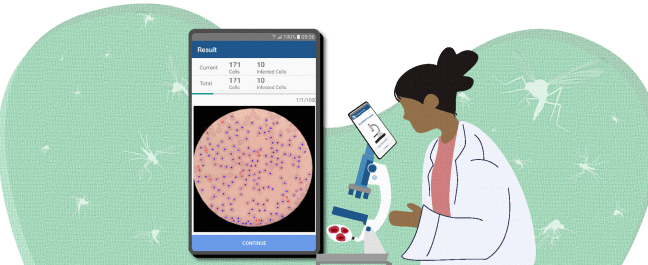Guest post by Stefan Jaeger, PhD, Staff Scientist for the Applied Clinical Informatics Branch of the Lister Hill National Center for Biomedical Communications, National Library of Medicine, National Institutes of Health.
Malaria is a highly transmissible disease spread through the bites of mosquitoes infected with Plasmodium parasites and is a significant cause of illness and death worldwide. One of the most promising ways to fight malaria is early detection, which requires fast and accurate diagnostic testing.
A common way to diagnose malaria in the field is by examining a smear of a drop of a patient’s blood under a microscope and manually counting the number of red blood cells and parasites to determine the parasitemia—the quantitative value of parasites in the blood and the degree of active infection.
Accurate parasite counts are essential to diagnosing malaria correctly. However, this manual approach has some limitations. For example, a typical manual count may take a well-trained microscopist 15 to 30 minutes per smear. This demand on time, as well as limited resources such as training, increases the possibility of misdiagnosis, which may lead to over- or underusing antibiotics and anti-malaria drugs and potential progression into severe malaria and death in case of false negatives.
NLM Malaria Screener
In collaboration with the NIH National Institute of Allergy and Infectious Diseases and the Mahidol-Oxford Tropical Medicine Research Unit in Bangkok, Thailand, NLM developed Malaria Screener, an automated artificial intelligence software system for Android smartphones that uses digital image analysis and machine learning to detect and count infected red blood cells and parasites in blood smear images. Automatic parasite counting has several advantages compared to manual counting—it’s more reliable and standardized and reduces the workload on malaria field workers so they can better serve their patients.
The software for Malaria Screener was developed by scanning thousands of images to learn the parasites’ typical shapes and visual appearances. Malaria Screener uses this training data and machine learning methods to detect whether parasites are present, discriminate between infected and uninfected cells, and automatically count the number of cells. When the smartphone is attached to a microscope, the Malaria Screener app can analyze blood smears and report the parasite count to the microscopist. Because Malaria Screener uses digital images acquired on standard light microscopy equipment, it is well suited for resource-limited settings.
In a field study of 190 patients recruited at two sites in rural areas near Khartoum, Sudan, Malaria Screener was 74% accurate in detecting the most deadly Plasmodium parasite, P. falciparum, with a processing time for each smear varying between 5 and 15 minutes. After improving the machine learning algorithms and using a different method to aggregate patient-level results, the software reached nearly 92% accuracy. The software also achieved 83% accuracy in identifying P. falciparum and P. vivax, the second most common Plasmodium species. This is an encouraging step toward an accurate automated system for malaria parasite screening.
What’s next: Applying this technology for vaccine development
By automating the testing process, NLM is also expediting the search for more effective treatments and preventions, including vaccines. In 2021, the World Health Organization approved the world’s first malaria vaccine, which specifically targets P. falciparum. However, the vaccine only modestly reduces clinical malaria, so a highly effective vaccine is still lacking.
To address this need, NLM is collaborating with the Malaria Research Institute at Johns Hopkins University to develop a new desktop application that processes images captured with a microscope and built-in camera. The application is informed by the machine learning methods that Malaria Screener uses to determine parasitemia and modifies them to demonstrate the efficacy of vaccine candidates. By automating parasite counts, a lab will have the enhanced capability to evaluate vaccine candidates.
Implementing an automated system such as Malaria Screener for parasite identification and automatic counting is expected to reduce the workload on health care professionals in the field so they can more accurately diagnose and treat malaria and save lives around the world. By expanding its capabilities, Malaria Screener could save months of work, help develop more effective treatments and preventions, and ultimately create better health outcomes.
Check out our video on Malaria Screener and its importance in the fight against malaria!

Stefan Jaeger, PhD
Staff Scientist, Applied Clinical Informatics Branch, Lister Hill National Center for Biomedical Communications, NLMDr. Jaeger received his diploma in computer science from the German Research Center for Artificial Intelligence (DFKI) at the University of Kaiserslautern and his PhD in computer science from the University of Freiburg. He has held research positions at the Chinese Academy of Sciences, the University of Maryland, the University of Karlsruhe, and Daimler, among others. At NLM, he leads a team that uses machine learning to diagnose infectious diseases and applies artificial intelligence and data science for clinical care and education. His other research interests include biomedical image analysis, medical informatics, and traditional medicine.
Time to deliver zero malaria: Invest. Innovate. Implement.
—The World Health Organization, in observance of World Malaria Day 2023
World Malaria Day is observed each year on April 25. This year, the World Health Organization (WHO) will focus on the third “I”—implement—and notably the critical importance of reaching marginalized populations with the tools and strategies that are available today.
Learn more at WHO.int.








